NCERT Solutions for Exercise 7.4 Class 10 Maths Chapter 7 - Coordinate Geometry
CBSE Class 10th Exam Date:01 Jan' 26 - 14 Feb' 26
NCERT Solutions for Class 10 Maths exercise 7.4 is the final and optional exercise in this chapter, and it covers all of the concepts from the entire chapter, including the distance formula, section formula, and triangle area. Coordinate Geometry is the study of geometry using coordinate points. The distance formula used to find the distance between two points in a two-dimensional plane is known as the Euclidean distance formula. The section formula is used to get the coordinates of the point that splits a line segment into a ratio either externally or internally. We can utilize the section when a point divides a line segment in some ratio either externally or internally.
This Story also Contains
- Coordinate Geometry Class 10 Chapter 7 Exercise: 7.1
- More About NCERT Solutions for Class 10 Maths Exercise 7.4:
- Benefits of NCERT Solutions for Class 10 Maths Exercise 7.4 :
NCERT solutions for Class 10 Maths chapter 7 exercise 7.4 consists of 8 questions in which 6 of them are long answer questions, 1 is a practical based question and the remaining 1 is a reasoning question. In NCERT book Class 10 Maths chapter 7 exercise 7.4, the ideas linked to the solution of coordinate geometry are well discussed. The following activities are included along with NCERT syllabus Class 10 Maths chapter 7 exercise 7.4.
Coordinate Geometry Class 10 Chapter 7 Exercise: 7.1
Answer:
Let the line divide the line segment AB in the ratio $k:1$ at point C.
Then, the coordinates of point C will be:
$C(x,y) = \left ( \frac{3k+2}{k+1},\frac{7k-2}{k+1} \right )$
Point C will also satisfy the given line equation $2x + y - 4 = 0$ , hence we have
$\Rightarrow 2\left ( \frac{3k+2}{k+1} \right )+\left (\frac{7k-2}{k+1} \right ) - 4 = 0$
$\Rightarrow \frac{6k+4+7k-2-4k-4}{k+1} = 0$
$\Rightarrow 9k-2 = 0$
$\Rightarrow k=\frac{2}{9}$
Therefore, the ratio in which the line $2x + y - 4 = 0$ divides the line segment joining the points $A(2,-2)$ and $B(3,7)$ is $2:9$ internally.
Q2 Find a relation between x and y if the points (x, y), (1, 2) and (7, 0) are collinear.
Answer:
If the points $(x, y), (1, 2)\ and\ (7, 0)$ are collinear then, the area formed by these points will be zero.
The area of the triangle is given by,
$Area = \frac{1}{2}\left [ x_{1}(y_{2}-y_{3})+x_{2}(y_{3}-y_{1})+x_{3}(y_{1}-y_{2}) \right ] = 0$
Substituting the values in the above equation, we have
$Area = \frac{1}{2}\left [ x(2-0)+1(0-y)+7(y-2) \right ]= 0$
$\Rightarrow 2x-y+7y-14= 0$
Or,
$\Rightarrow x+3y-7= 0$
Hence, the required relation between x and y is $x+3y-7= 0$ .
Q3 Find the center of a circle passing through the points (6, – 6), (3, – 7) and (3, 3).
Answer:
From the figure:
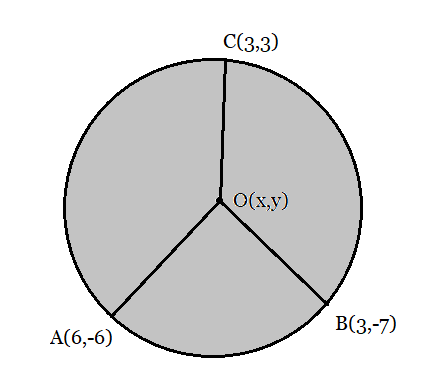
Let the center point be $O(x,y)$ .
Then the radii of the circle $OA,\ OB,\ and\ OC$ are equal.
The distance OA:
$OA = \sqrt{(x-6)^2+(y+6)^2}$
The distance OB:
$OB = \sqrt{(x-3)^2+(y+7)^2}$
The distance OC:
$OC = \sqrt{(x-3)^2+(y-3)^2}$
Equating the radii of the same circle.
When equating, $OA = OB$
$\sqrt{(x-6)^2+(y+6)^2}= \sqrt{(x-3)^2+(y+7)^2}$
Squaring both sides and applying $a^2-b^2 = (a+b)(a-b)$
$\Rightarrow (x-6+x-3)(x-6-x+3)+(y+6+y+7)(y+6-y-7) = 0$
$\Rightarrow (2x-9)(-3) + (2y+13)(-1) = 0$
$\Rightarrow -6x+27-2y-13 = 0$ or
$\Rightarrow 3x+y -7= 0$ ...................................(1)
When equating, $OA = OC$
$\sqrt{(x-6)^2+(y+6)^2}= \sqrt{(x-3)^2+(y-3)^2}$
Squaring both sides and applying $a^2-b^2 = (a+b)(a-b)$
$\Rightarrow (x-6+x-3)(x-6-x+3)+(y+6+y-3)(y+6-y+3) = 0$
$\Rightarrow (2x-9)(-3) + (2y+3)(9) = 0$
$\Rightarrow -3x+9y+27 = 0$ ...................................(2)
Now, adding the equations (1) and (2), we get
$\Rightarrow 10y = -20$
$\Rightarrow y = -2$ .
From equation (1), we get
$\Rightarrow 3x-2 = 7$
$\Rightarrow 3x =9$
$\Rightarrow x =3$
Therefore, the centre of the circle is $(3,-2)$ .
Answer:
From the figure:
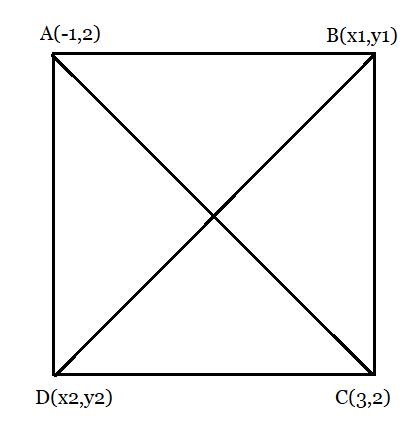
We know that the sides of a square are equal to each other.
Therefore, AB = BC
So,
$\sqrt{(x-1)^2+(y-2)^2} = \sqrt{(x-3)^2+(y-2)^2}$
Squaring both sides, we obtain
$\implies (x-1)^2+(y-2)^2 = (x-3)^2+(y-2)^2$
Now, doing $\left ( a^2-b^2 = (a+b)(a-b) \right )$
We get
$\implies (x-1+x-3)(x-1-x+3) = 0$
Hence $x = 2$ .
Applying the Pythagoras theorem to find out the value of y.
$AB^2+BC^2 = AC^2$
$(\sqrt{(2-1)^2+(y-2)^2})^2 + (\sqrt{(2-3)^2+(y-2)^2})^2 = (\sqrt{(3+1)^2+(2-2)^2})^2$
$\Rightarrow \left (\sqrt{1+(y-2)^2} \right )^2 + \left (\sqrt{1+(y-2)^2} \right )^2 = \left (\sqrt{16} \right )^2$
$\Rightarrow (y-2)^2 = 7$
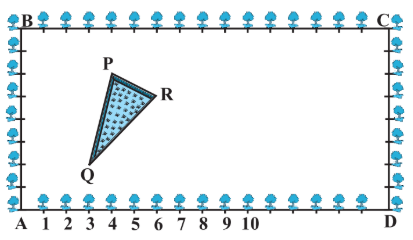
Answer:
Taking A as origin then, the coordinates of P, Q, and R can be found by observation:
Coordinates of point P is $(4,6).$
Coordinates of point Q is $(3,2).$
Coordinates of point R is $(6,5).$
The area of the triangle, in this case, will be:
$Area =\frac{1}{2}\left [ x_{1}(y_{2}-y_{3})+x_{2}(y_{3}-y_{1})+x_{3}(y_{1}-y_{2}) \right ]$
$=\frac{1}{2}\left [ 4(2-5)+3(5-6)+6(6-2) \right ]$
$=\frac{1}{2}\left [ -12-3+24\right ] = \frac{9}{2}\ Square\ units.$
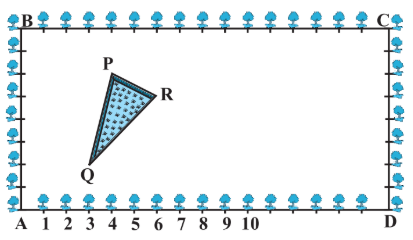
Answer:
Taking C as origin, then CB will be x-axis and CD be y-axis.
The coordinates fo the vertices P, Q, and R are: $(12,2),\ (13,6),\ (10,3).$ respectively.
The area of the triangle, in this case, will be:
$Area =\frac{1}{2}\left [ x_{1}(y_{2}-y_{3})+x_{2}(y_{3}-y_{1})+x_{3}(y_{1}-y_{2}) \right ]$
$=\frac{1}{2}\left [ 12(6-3)+13(3-2)+10(2-6) \right ]$
$=\frac{1}{2}\left [ 36-13+40 \right ] = \frac{9}{2}\ Square\ units.$
It can be observed that in both cases the area is the same so, it means that the area of any figure does not depend on the reference which you have taken.
Answer:
From the figure:
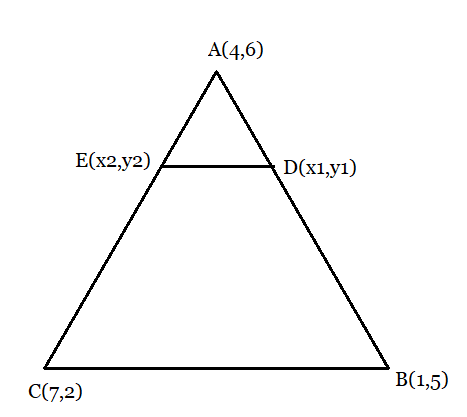
Given ratio:
$\frac{AD }{AB} = \frac{AE }{AC } = \frac{1}{4}$
Therefore, D and E are two points on side AB and AC respectively, such that they divide side AB an AC in the ratio of $1:3$ .
Section formula:
$P(x,y)= \left (\frac{m_{1}x_{2}+m_{2}x_{1}}{m_{1}+m_{2}} , \frac{m_{1}y_{2}+m_{2}y_{1}}{m_{1}+m_{2}} \right )$
Then, coordinates of point D:
$D(x_{1},y_{1})= \left (\frac{1\times1+3\times 4}{1+3} , \frac{1\times 5+3\times 6}{1+3} \right )$
Coordinates of point E:
$E(x_{2},y_{2})= \left (\frac{1\times7+3\times 4}{1+3} , \frac{1\times 2+3\times 6}{1+3} \right )$
$= \left ( \frac{19}{4}, \frac{20}{4} \right )$
Then, the area of a triangle:
$= \frac{1}{2}\left [ x_{1}(y_{2}-y_{3})+x_{2}(y_{3}-y_{1})+x_{3}(y_{1}-y_{2}) \right ]$
Substituting the values in the above equation,
$Area\ of\ \triangle ADE = \frac{1}{2}\left [ 4\left ( \frac{23}{4} - \frac{20}{4}\right )+\frac{13}{4}\left ( \frac{20}{4} - 6 \right )+\frac{19}{4}\left (6-\frac{23}{4} \right )\right ]$ $= \frac{1}{2}\left [ 3-\frac{13}{4} +\frac{19}{16}\right ] = \frac{1}{2}\left [ \frac{48-52+19}{16} \right ] = \frac{15}{32}\ square\ units.$
$Area\ of\ \triangle ABC = \frac{1}{2}\left [ 4(5-2)+1(2-6)+7(6-5) \right ]$
$= \frac{1}{2}\left [ 12-4+7 \right ] = \frac{15}{2}\ Square\ units.$
Hence the ratio between the areas of $\triangle ADE$ and $\triangle ABC$ is $1:16.$
Answer:
From the figure:
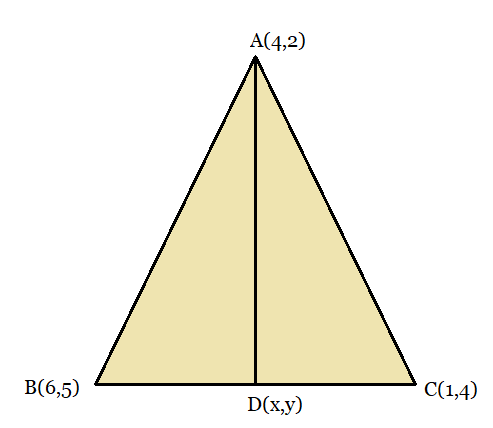
Let AD be the median of the triangle
Then, D is the mid-point of BC
Coordinates of Point D:
$\left ( \frac{6+1}{2},\frac{5+4}{2} \right ) = \left ( \frac{7}{2}, \frac{9}{2} \right )$
Answer:
From the figure,
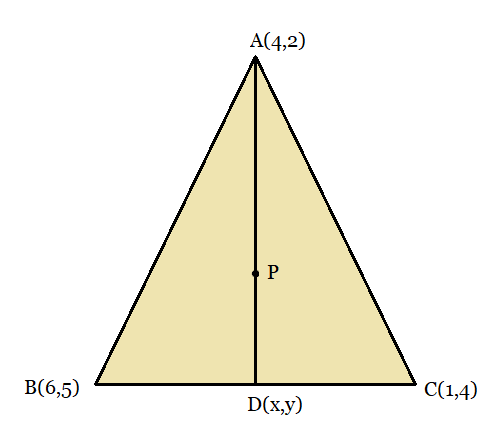
The point P divides the median AD in the ratio, AP: PD = 2: 1
Hence using the section formula,
$P(x,y)= \left (\frac{m_{1}x_{2}+m_{2}x_{1}}{m_{1}+m_{2}} , \frac{m_{1}y_{2}+m_{2}y_{1}}{m_{1}+m_{2}} \right )$
$P(x,y)= \left (\frac{2\times\frac{7}{2}+1\times4}{2+1} , \frac{2\times\frac{9}{2}+1\times2}{2+1} \right ) = \left ( \frac{11}{3}, \frac{11}{3} \right )$
Answer:
From the figure,
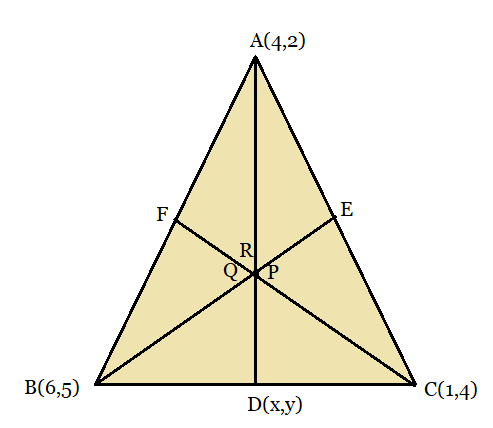
$\Rightarrow$ The point Q divides the median BE in the ratio, BQ : QE = 2 : 1
Hence using the section formula,
$Q(x,y)= \left (\frac{m_{1}x_{2}+m_{2}x_{1}}{m_{1}+m_{2}} , \frac{m_{1}y_{2}+m_{2}y_{1}}{m_{1}+m_{2}} \right )$
$Q(x,y)= \left (\frac{2\times\frac{5}{2}+1\times6}{2+1} , \frac{2\times3+1\times5}{2+1} \right ) = \left ( \frac{11}{3}, \frac{11}{3} \right )$
$\Rightarrow$ The point R divides the median CF in the ratio, CR: RF = 2: 1
Hence using the section formula,
$R(x,y)= \left (\frac{m_{1}x_{2}+m_{2}x_{1}}{m_{1}+m_{2}} , \frac{m_{1}y_{2}+m_{2}y_{1}}{m_{1}+m_{2}} \right )$
$R(x,y)= \left (\frac{2\times 5+1\times1}{2+1} , \frac{2\times\frac{7}{2}+1\times4}{2+1} \right ) = \left ( \frac{11}{3}, \frac{11}{3} \right )$
Q7 (iv) Let A (4, 2), B(6, 5) and C(1, 4) be the vertices of D ABC. What do you observe?
Answer:
We observed that the coordinates of P, Q, and R are the same. Therefore, all these are representing the same point on the plane. i.e., the centroid of the triangle.
Answer:
From the figure, 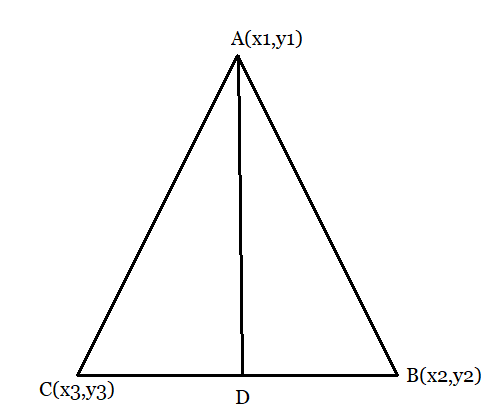
Let the median be AD which divides the side BC into two equal parts.
Therefore, D is the mid-point of side BC.
Coordinates of D:
$= \left ( \frac{x_{2}+x_{3}}{2}, \frac{y_{2}+y_{3}}{2} \right )$
Let the centroid of this triangle be O.
Then, point O divides the side AD in a ratio 2:1.
Coordinates of O:
$= \left ( \frac{2\times\frac{x_{2}+x_{3}}{2}+1\times x_{1}}{2+1}, \frac{2\times\frac{y_{2}+y_{3}}{2}+1\times y_{1} }{2+1} \right )$
$= \left ( \frac{x_{1}+x_{2}+x_{3}}{3}, \frac{y_{1}+y_{2}+y_{3}}{3} \right )$
Answer:
From the figure:
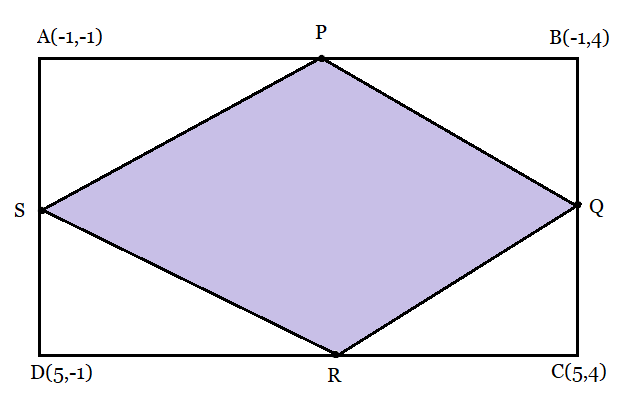
P is the mid-point of side AB.
Therefore, the coordinates of P are, $\left ( \frac{-1-1}{2}, \frac{-1+4}{2} \right ) = \left ( -1, \frac{3}{2} \right )$
Similarly, the coordinates of Q, R and S are: $\left ( 2,4 \right ),\ \left ( 5, \frac{3}{2} \right ),\ and\ \left ( 2,-1 \right )$ respectively.
The distance between the points P and Q:
$PQ = \sqrt{(-1-2)^2+\left ( \frac{3}{2} -4 \right )^2} = \sqrt{9+\frac{25}{4}} = \sqrt{\frac{61}{4}}$
and the distance between the points Q and R:
$QR = \sqrt{(2-5)^2+\left ( 4-\frac{3}{2} \right )^2} = \sqrt{9+\frac{25}{4}} = \sqrt{\frac{61}{4}}$
Distance between points R and S:
$RS = \sqrt{(5-2)^2+\left ( \frac{3}{2}+1 \right )^2} = \sqrt{9+\frac{25}{4}} = \sqrt{\frac{61}{4}}$
Distance between points S and P:
$SP = \sqrt{(2+1)^2+\left ( -1-\frac{3}{2} \right )^2} = \sqrt{9+\frac{25}{4}} = \sqrt{\frac{61}{4}}$
Distance between points P and R the diagonal length:
$PR = \sqrt{(-1-5)^2+\left ( \frac{3}{2}-\frac{3}{2} \right )^2} = 6$
Distance between points Q and S the diagonal length:
$QS = \sqrt{(2-2)^2+\left ( 4+1 \right )^2} = 5$
Hence, it can be observed that all sides have equal lengths. However, the diagonals are of different lengths.
Therefore, PQRS is a rhombus.
More About NCERT Solutions for Class 10 Maths Exercise 7.4:
The midpoint and area of the quadrilateral were also covered in the NCERT solutions for Class 10 Maths exercise 7.4. The questions in exercise 7.3 Class 10 Maths are based on concepts such as the distance formula, section formula, and triangle area. When a point P(x,y) divides the line segment into two segments, with marked points as A(x1,y1) and B(x2,y2) the method used to find the coordinates of that point is known as the section formula that is covered in the Class 10 Maths chapter 7 exercise 7.4.
Also Read| Coordinate Geometry Class 10 Notes
Benefits of NCERT Solutions for Class 10 Maths Exercise 7.4 :
• NCERT solutions for Class 10 Maths exercise 7.4 are carefully drafted to assist the student in scoring good marks in the examination. That's why any student can easily score the highest possible marks in the final exam.
• From exercise 7.4 Class 10 Maths we can easily understand the pattern of questions that can be asked in term exams from this chapter and also know the marks weightage of the chapter. From that, they can prepare themselves accordingly for the final examination.
• NCERT solution for Class 10 Maths chapter 7 exercise 7.4 exercises, will be helpful in the further exercise of chapter 10.
Questions related to CBSE Class 10th
On Question asked by student community
Good Morning, candidate,
The question papers will be available soon at the link attached herewith. You can keep an eye on the website of careers360. it will provide you perfect pattern of question papers, which will improve your writing skills and practice learning.
https://school.careers360.com/articles/cbse-sahodaya-class-10-pre-board- question-paper-2025-26
Thank you.
Hello,
You can download subject wise CBSE Sahodaya Class 10 Pre-Board Question Paper 2025-26 for Round 1 & Round 2 from this link : CBSE Sahodaya Class 10 Pre-Board Question Paper 2025-26
Hope it helps !
Hello there,
Solving question papers is one of the best method of preparation. It gives you proper idea about the exam pattern and important topics to cover.
Here is the link attached from the official website of Careers360 which will provide you with the CBSE Sahodaya question papers. Hope it helps!
https://school.careers360.com/articles/sahodaya-question-paper-2025
thank you!
The CBSE Class 10 Hindi Question Paper Blueprint (Marking Pattern) for the 2025-2026 Board Exam is divided into four main sections, with a total of 80 marks for the written exam. The structure is slightly different for Hindi Course A and Hindi Course B.You can download the official Sample Question Paper (SQP) and its Marking Scheme for both Hindi Course A and Course B here: https://school.careers360.com/boards/cbse/cbse-class-10-hindi-sample-papers-2025-26
The CBSE Sahodaya Question Papers for Class 10 (2025-26) are not released centrally by the board as a single PDF.
Here is the essential information you need:
-
Local Release: The papers are designed and released by the individual Sahodaya School Clusters (groups of CBSE schools) just before or during the pre-board exam dates (typically held in December and January). Therefore, you must check your local cluster's portal or directly with your school administration.
-
Best Practice: The official model papers, based on the full 2026 syllabus, are the most reliable tool for practice. These accurately reflect the structure, format, and competency-based questions used in the Sahodaya exams.
You can download the latest CBSE Class 10 Model Papers to simulate the Sahodaya tests here: https://school.careers360.com/articles/sahodaya-question-paper-2025 . Focus on that pattern
Applications for Admissions are open.
As per latest syllabus. Physics formulas, equations, & laws of class 11 & 12th chapters
JEE Main Important Chemistry formulas
Get nowAs per latest syllabus. Chemistry formulas, equations, & laws of class 11 & 12th chapters
JEE Main high scoring chapters and topics
Get nowAs per latest 2024 syllabus. Study 40% syllabus and score upto 100% marks in JEE
JEE Main Important Mathematics Formulas
Get nowAs per latest syllabus. Maths formulas, equations, & theorems of class 11 & 12th chapters
